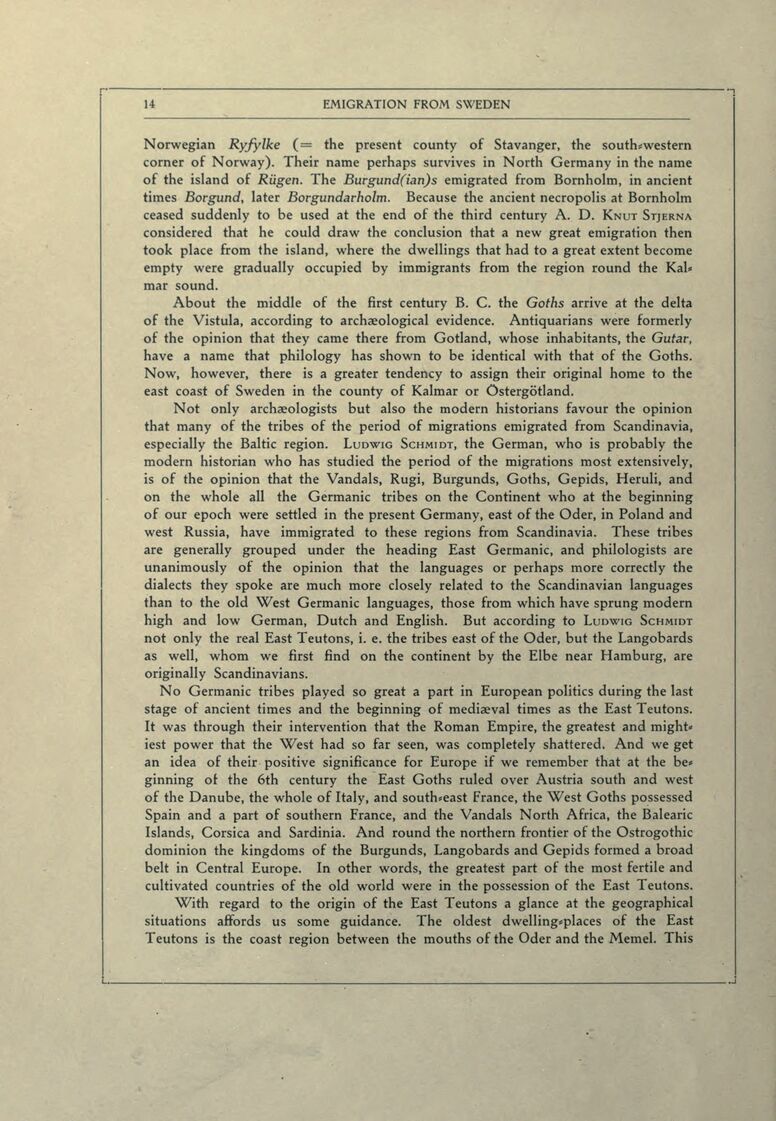
Full resolution (JPEG) - On this page / på denna sida - Part I - Professor Otto von Friesen, Uppsala, Emigration from Sweden in Ancient Times

<< prev. page << föreg. sida << >> nästa sida >> next page >>
Below is the raw OCR text
from the above scanned image.
Do you see an error? Proofread the page now!
Här nedan syns maskintolkade texten från faksimilbilden ovan.
Ser du något fel? Korrekturläs sidan nu!
This page has never been proofread. / Denna sida har aldrig korrekturlästs.
Norwegian Ryfylke (= the present county of Stavanger, the south*western
corner of Norway). Their name perhaps survives in North Germany in the name
of the island of Riigen. The Burgund(ian)s emigrated from Bornholm, in ancient
times Borgund, later Borgundarholm. Because the ancient necropolis at Bornholm
ceased suddenly to be used at the end of the third century A. D. Knut Stjerna
considered that he could draw the conclusion that a new great emigration then
took place from the island, where the dwellings that had to a great extent become
empty were gradually occupied by immigrants from the region round the Kai*
mar sound.
About the middle of the first century B. C. the Goths arrive at the delta
of the Vistula, according to archæological evidence. Antiquarians were formerly
of the opinion that they came there from Gotland, whose inhabitants, the Gutar,
have a name that philology has shown to be identical with that of the Goths.
Now, however, there is a greater tendency to assign their original home to the
east coast of Sweden in the county of Kalmar or Östergötland.
Not only archæologists but also the modern historians favour the opinion
that many of the tribes of the period of migrations emigrated from Scandinavia,
especially the Baltic region. Ludwig Schmidt, the German, who is probably the
modern historian who has studied the period of the migrations most extensively,
is of the opinion that the Vandals, Rugi, Burgunds, Goths, Gepids, Heruli, and
on the whole all the Germanic tribes on the Continent who at the beginning
of our epoch were settled in the present Germany, east of the Oder, in Poland and
west Russia, have immigrated to these regions from Scandinavia. These tribes
are generally grouped under the heading East Germanic, and philologists are
unanimously of the opinion that the languages or perhaps more correctly the
dialects they spoke are much more closely related to the Scandinavian languages
than to the old West Germanic languages, those from which have sprung modern
high and low German, Dutch and English. But according to Ludwig Schmidt
not only the real East Teutons, i. e. the tribes east of the Oder, but the Langobards
as well, whom we first find on the continent by the Elbe near Hamburg, are
originally Scandinavians.
No Germanic tribes played so great a part in European politics during the last
stage of ancient times and the beginning of mediaeval times as the East Teutons.
It was through their intervention that the Roman Empire, the greatest and might*
iest power that the West had so far seen, was completely shattered. And we get
an idea of their positive significance for Europe if we remember that at the be*
ginning of the 6th century the East Goths ruled over Austria south and west
of the Danube, the whole of Italy, and south*east France, the West Goths possessed
Spain and a part of Southern France, and the Vandals North Africa, the Balearic
Islands, Corsica and Sardinia. And round the northern frontier of the Ostrogothic
dominion the kingdoms of the Burgunds, Langobards and Gepids formed a broad
belt in Central Europe. In other words, the greatest part of the most fertile and
cultivated countries of the old world were in the possession of the East Teutons.
With regard to the origin of the East Teutons a glance at the geographical
situations affords us some guidance. The oldest dwelling*places of the East
Teutons is the coast region between the mouths of the Oder and the Memel. This
<< prev. page << föreg. sida << >> nästa sida >> next page >>